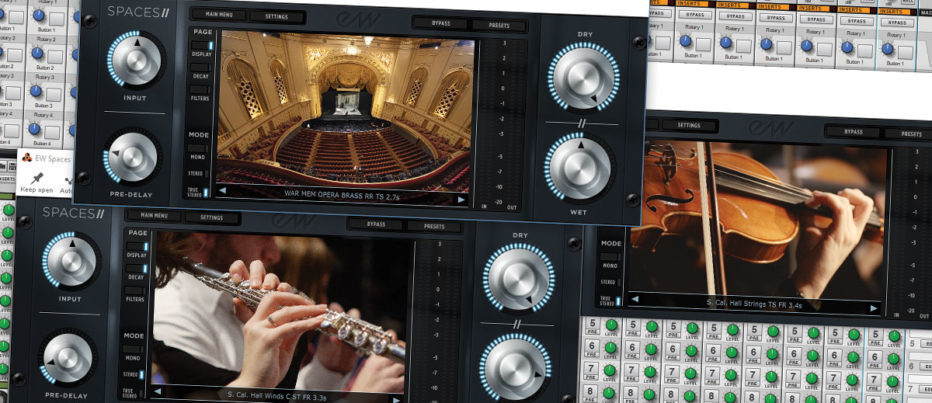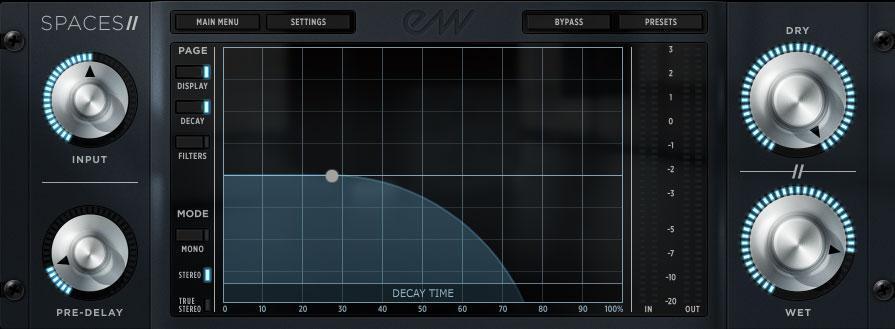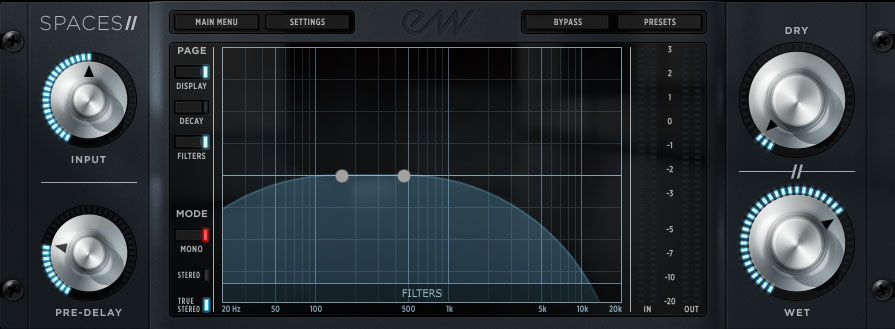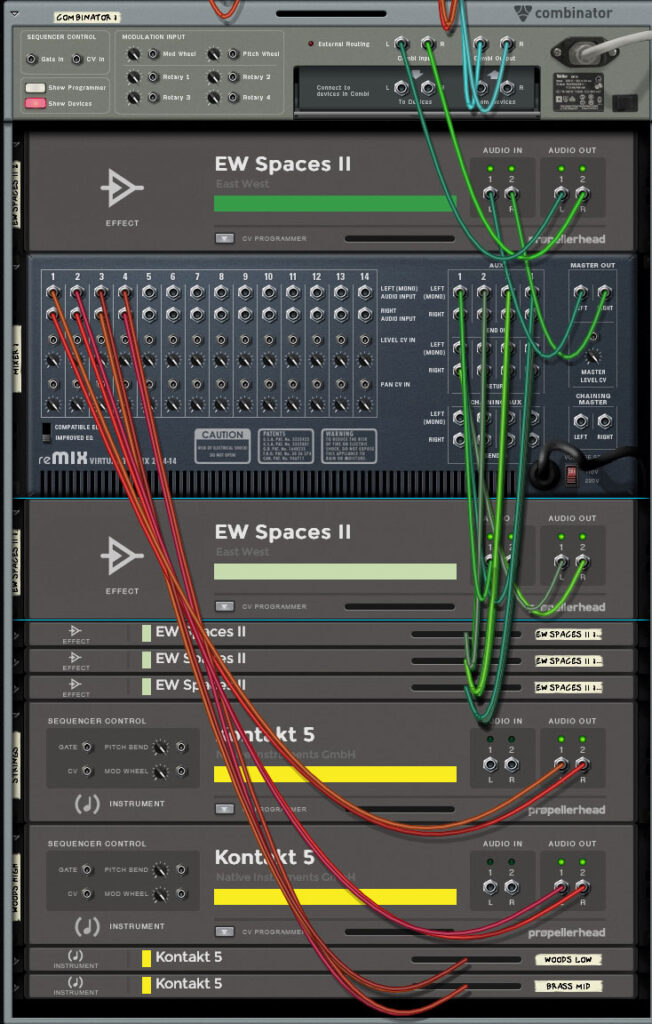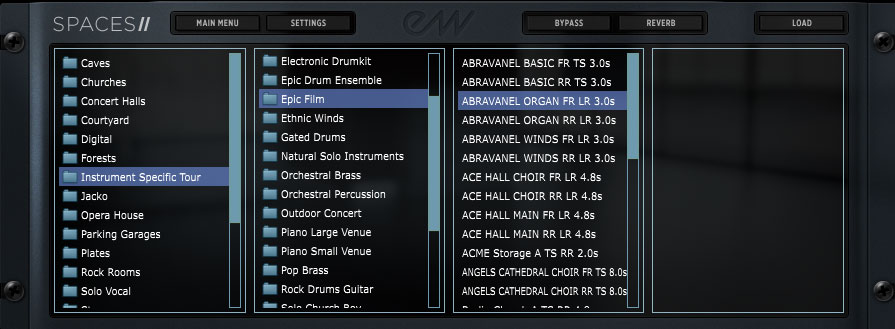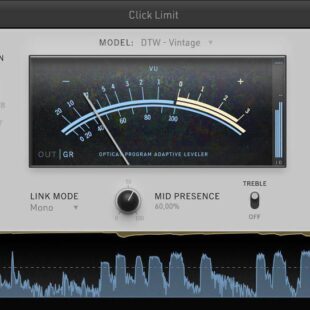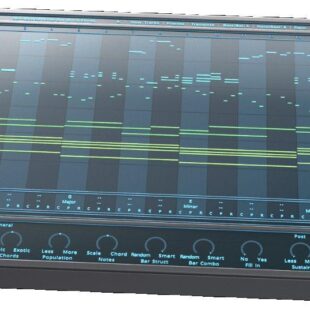EASTWEST SPACES 2 – FULL SPECTRUM
Welcome to Music Nation. This week we’re taking a close look at EastWest‘s latest edition of their incredible reverb plugin, Spaces 2. Readers familiar with the company’s Play Engine virtual instruments will already have a taste of how well EastWest does reverb. This stand-alone plugin expands on this with more in-depth controls, flexibility and a massive selection of presets.
Convolution reverb technology has always been the most realistic of effects but the processing demands are usually prohibitive on modest systems due to the cost of system resources. With modern PCs, however, this issue is mostly solved. Now with so many other developers looking at new and unique ways to offer process effects, Spaces 2 may come across as a little old-fashioned before it is even out of the box.
Overview
Spaces 2 is a VST convolution reverb plugin featuring a total of 1020 individual impulses comprising 55 unique location recordings and 372 instrument-specific banks (including all the original Spaces 1 presets). There is an RRP of $399 USD to buy it outright (though it looks to be on permanent sale at $299). You can sign up for ComposerCloud and have it included in your monthly subscription for $24.99/month.
A simple download and installation process is required and the plugin shows up in your collection ready to be inserted or set up as a BUS send. Testament to the total amount of convolution recordings included, Spaces 2 requires a massive 1.7GB of disc space. I tested Spaces 2 in Reason Studio, Cubase 9.5, StudioOne 4, Samplitude, Waveform9 and Reaper, all with no troubles or hiccups.
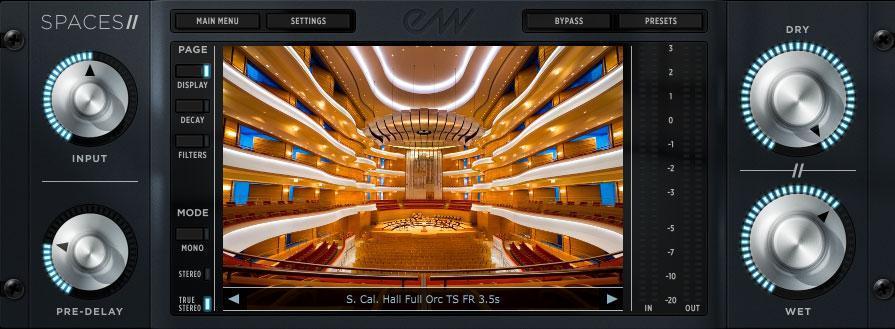
Looking Cool
Space 2 is about as traditional as you can get with plugin design. The slick new interface is an improvement visually over the original Spaces 1, but it comes at the expense of more buttons and menu diving. There are no size scaling options, so on our widescreen video monitor Spaces 2 looks positively tiny, especially the buttons and fonts, which are difficult to read. The i/o meters have now been turned vertical and the facia has a cool new dark grey paint job.
Though Spaces 2 certainly looks more contemporary, I question EastWest’s decision again to dedicate large sections of their interfaces to mostly unimportant features like location photos. While it’s a little interesting to know what the recorded space looks like, I would have much rather the real estate dedicated to the patch browser, direct access to the filter, decay controls or just simply larger fonts.
The browser is rudimentary, with no option to search or to mark favourites which is a problem. A tag-sensitive search option would have been handy here because until you become familiar with the presets it is largely guesswork as to what they sound like.
The Sound
Comparing Spaces 2 with other similar products in some kind of shoot-out scenario is difficult as the impulse recordings are not only unique to the locations but also the equipment and recording process used on site.
It can also be unfair also to criticise reverb effects as so many variables can sway your opinion either way. Though I feel the included environmental effects of regular halls, churches, clubs, and stages are mostly very good, there is nothing overly extraordinary. I particularly like the digital presets available and the solo vocal category is mostly excellent, but ultimately the included presets are very bread-and-butter basic.
It’s great the essentials are well covered, but I was hoping for perhaps a few more leftfield or bizarre presets to stir creativity. However, even though at first look the included selection felt a little flat, the only way to judge the value of a device like this is to apply it to multiple scenarios and listen.
Focusing on the impulse character and quality, it is my opinion the tail-end maketh the reverb, and to this end, Spaces 2 consistently sounds better than everything I tested alongside it. Initial room ambience often sounds good, but getting that smooth, glassy release tail is where the quality can be heard, and this is where Spaces 2 excels.
Even while testing with very wet settings using high-dynamic snare hits and synth pulses, all presets displayed fabulous details in the tail. Some of the darker, church-like locations such as the Abandoned Abbey preset, are extremely immersive. Hearing the reverb echoing off the wet walls as it winds down deeper into the catacombs is quite chilling.
Digging Deeper: Instrument-specific patches.
Though it’s easy to simply slap a reverb effect on an instrument and call the job done, Spaces 2 requires more finesse to match the right combination of source-to-reverb effect to the instrument-specific patches.
EastWest provides a large number of these specialised convolutions, curated using impulse speaker positions set up to emulate the sound generated directly from the instrument at the correct position on stage. A novel idea which can be used as a quick starting point when working with solo instruments
Taking the time to set up an orchestral template, each with a unique instance of Spaces 2 and the correctly paired instrument-specific reverb effect resulted in outstanding results which were better than I was expecting. This always provides night-and-day results over simply sending the full mix to an AUX send.
The instrument-specific presets do limit your choice of location in the traditional seating arrangements. The only real option is for the pulse length, usually between 2-4 seconds. I did not find this problematic, as I was not explicitly looking to reproduce the environment from a particular location. I was mostly happy with whatever EastWest supplied.
I spent some time creating templates for various orchestral groups as well; smaller chamber bands, a larger symphonic group and even a prog-rock style setup with synths, drums and guitar. Though it was somewhat tedious to create these templates, in all situations Spaces 2 provided remarkable improvements on the mix image and balance when split out into individual specific instances.
This process is clearly better suited to large ensembles and orchestral groups, towards which most of the presets are targeted. Although it is a lengthy process matching the reverb to the source, the results are quite impressive. There are distinctive clarity and spatial differences in splitting the orchestra out like this rather than simply throwing a global effect on a BUS channel.
Typically, one would apply an EQ or use the built-in filter to remove much of the low-end mush present when BUS reverb processing. Though you still need to be conscious of send levels, this low-end issue is dramatically reduced using this split process, resulting in a much clearer and broader ambience. Also, to a lesser degree, sustained notes are more defined and when held, show less tendency to ring when overlapping.
Spaces 2 also responds remarkably well to dual-reverb processing. Applying a tight, small room adds body before a second, larger, long-tailed effect. Some fun can be had using an auto-panner into two unique reverb effects as well, though more applicable to synths and SFX than vocals.
Though this is encouraging, sound design is possibly the only area Spaces 2 that might disappoint. There are no LFOs or gate filters, nothing experimental or hybrid built-in. No options to morph and mangle the effect with a nice collection of tailored effects which definitely would have opened up its appeal to more producers.
Unfortunately, you cannot import your own impulse response to Spaces 2.
Watch our brief demonstration of the instrument-specific process.
Conclusion
This is a rather expensive sector of the market to invest in, Spaces 2’s closest rival is Altiverb retails at around $595 (or a whopping $995 for the full surround version), making Spaces 2’s $399 RRP price tag look like an absolute bargain.
Spaces 2’s biggest competition are the simple free convolution reverb players included with all DAWs these days. Some, like Reaper and StudioOne, require purchasing high-quality 3rd party impulse libraries to be comparable, other such as Cubase and Samplitude comes with a sizable collection out of the box.
One thing that has been clear throughout my testing is that reverbs are all very subjective. There are so many variables making a comparison between devices impossible. Spaces 2 has a detailed and more open sound to me, but that doesn’t necessarily make it better – just different.
The Spaces 1 upgrade price of $199 USD for what is essentially an expansion feels a bit steep to me, mostly because the first edition contains the vast majority of what makes Spaces amazing. But for new customers, it is difficult to look past the enormous amount of content here and its stellar results.
Certainly, Spaces 2’s point of difference is the instrument-specific convolutions which are a triumph. For orchestral, film and TV producers this will provide next-level results and this feature alone makes Spaces 2 required buying. Spaces 2 will no doubt find its way into the collections of all top professionals who will appreciate the effort EastWest have put into creating these first-class convolutions. At the other end of the scale, the subtleties might be lost on casual musicians and bedroom producers.
As for a daily go-to reverb plugin, Spaces 2 may only provide a subtle degree of refinement over the competition or even its own predecessor. However, its fine details when you get to the high end of the spectrum will make or break a project. For those who can make good use of the extended features, the payoff will be truly spectacular. And to that end, Spaces 2 is in my view one of the most capable convolution reverb plugins available.
Full details on Spaces 2 and EastWest’s Composer Cloud is available on their website here www.soundsonline.com
Like the review? Shout us a cup of coffee!

